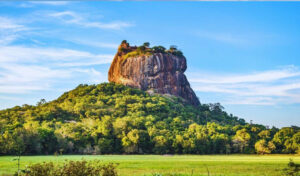Lankathilaka Raja Maha Viharaya is one of the most fascinating temples constructed in the Gampola Era. It is situated atop the Panhalgala Rock in the Hiyarapitiya Village from the Udunuwara area of the Kandy district and was constructed by the Chieftain, Senadhilankara, under the auspices of the first King of Gampola, Buwanekabahu IV in 1344.
There are two main access points to this architectural marvel. One of them is through the Sanghawasa, the dwelling place of monks. Visitors entering this way can view large rice storage bins known as ‘Atuwa’ within these premises. The second approach is from the west of the temple. Both routes are equally scenic, offering some mesmerising views of the surroundings as you climb up the steps that have been carved into the Panhalgala Rock.
There is certainly a lot to see in the temple grounds, which has three main sections: the temple, the dagoba and the Bo Tree. Situated on the eastern side, the main temple houses a golden statue of the seated Buddha. Above the statue is an unusual ‘Makara Thorana’ or dragon arch, sculpted with angels watching over Lord Buddha. The inside walls are covered in the most ornate paintings known as the ‘Suvisi Vivarana’, the lives of 24 past Buddhas. The ceiling too is decorated with the most attractive murals.
It was in the Gampola Era that Hindu deities were incorporated into Buddhist temples and so on the west side of the Lankathilaka temple premises is found the House of Gods. Many flock here to offer homage to Vishnu, Saman, Vibhishana, Ganapathi, Skandhakumãra and Kumara Bandãra, who, interestingly, is believed to be entrusted with the task of protecting the Lankathilaka.
This grand temple was designed by South Indian architect Sathapati Ravar. While he mainly utilised patterns of the Gedige type, the architecture of the Polonnaruwa era, he also incorporated Dravidian and Indo-Chinese designs, thus vesting the structure with its own unique form.
The temple is also unusual in that it is built over an uneven rock surface, using a granite foundation. Originally made up of four storeys and standing at eighty feet tall, only the ground floor and a part of the first floor are visible today. However, when viewed from outside it looks as though the temple has three levels.
Wandering through the premises of the Lankathilaka Raja Maha Viharaya, it becomes plainly obvious as to why many consider this to be the most magnificent temple of the Gampola Era. Every part of it, both inside and outside, is beautiful. The detail in the architecture, sculpture and paintings makes viewing it a visual treat.



